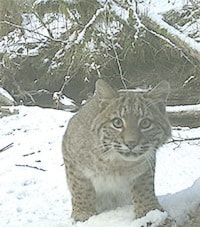UBC Okanagan master’s candidate TJ Gooliaff is asking for the public’s help with photographs of lynx and bobcats sited in the Quesnel and Prince George area.
As part of his masters thesis in biology, Gooliaff is studying the effects of climate change on the habitat and range of these two big cats.
As part of his research, Gooliaff offered the following information on the difference between these two wild cats.
“Historically, bobcats and lynx have been typically separated by snow depth. Lynx have extremely long legs and large snowshoe-like paws, making them well adapted for traveling across deep snow. They are found in the boreal forests across Canada and Alaska, as well as the mountain ranges extending south into the western states. In contrast, the bobcats are heavier, have small feet and sink into the snow. They are found throughout the deserts and grasslands of the continguous United States as well as southern Canada. However, climate change has led to earlier springs and lower snow levels. As a result, suitable bobcat habitat may now be present in new areas of B.C. I hypothesize that bobcats have moved northwards and into higher elevations.”
To prove or disprove this theory, Gooliaff is seeking local photographs of both lynx and bobcats captured by trail cameras, or conventional cameras, from all corners of the province and from all time periods to help determine the provincial distribution of each species. Preliminary findings suggest that the bobcat front (known limit of territory) is somewhere around Quesnel/Prince George and he is therefore targeting this area for both bobcat and lynx photos to help identify the northern limit of the bobcat and to compare where bobcats occur in relation to lynx.
“The photos do not have to be great photography, they just have to show a bobcat or lynx, or even just a part of one,” Gooliaff said.
“Photos can be blurry or dark and don’t even have to clearly show which cat species is present. Photos will not be published or shared with anyone without permission and photographers will retain ownership of their photos.”
He added he will gladly share the results of his study with all those interested.
Anyone with photos can send them, along with date and location of each photo to tj.gooliaff@ubc.ca.
